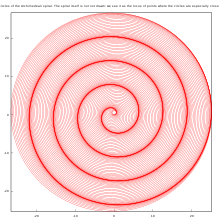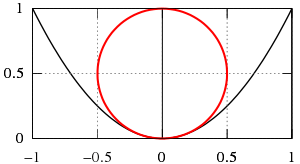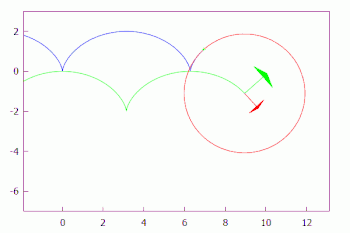Osculating circle
In differential geometry of curves, the osculating circle of a sufficiently smooth plane curve at a given point p on the curve has been traditionally defined as the circle passing through p and a pair of additional points on the curve infinitesimally close to p. Its center lies on the inner normal line, and its curvature defines the curvature of the given curve at that point. This circle, which is the one among all tangent circles at the given point that approaches the curve most tightly, was named circulus osculans (Latin for "kissing circle") by Leibniz.


The center and radius of the osculating circle at a given point are called center of curvature and radius of curvature of the curve at that point. A geometric construction was described by Isaac Newton in his Principia:
There being given, in any places, the velocity with which a body describes a given figure, by means of forces directed to some common centre: to find that centre.
— Isaac Newton, Principia; PROPOSITION V. PROBLEM I.
Nontechnical description
Imagine a car moving along a curved road on a vast flat plane. Suddenly, at one point along the road, the steering wheel locks in its present position. Thereafter, the car moves in a circle that "kisses" the road at the point of locking. The curvature of the circle is equal to that of the road at that point. That circle is the osculating circle of the road curve at that point.
Mathematical description
Let (s) be a regular parametric plane curve, where s is the arc length (the natural parameter). This determines the unit tangent vector T(s), the unit normal vector N(s), the signed curvature k(s) and the radius of curvature R(s) at each point for which s is composed:
Suppose that P is a point on γ where k ≠ 0. The corresponding center of curvature is the point Q at distance R along N, in the same direction if k is positive and in the opposite direction if k is negative. The circle with center at Q and with radius R is called the osculating circle to the curve γ at the point P.
If C is a regular space curve then the osculating circle is defined in a similar way, using the principal normal vector N. It lies in the osculating plane, the plane spanned by the tangent and principal normal vectors T and N at the point P.
The plane curve can also be given in a different regular parametrization
where regular means that for all . Then the formulas for the signed curvature k(t), the normal unit vector N(t), the radius of curvature R(t), and the center Q(t) of the osculating circle are
Cartesian coordinates
We can obtain the center of the osculating circle in Cartesian coordinates if we substitute and for some f function. If we do the calculations the results for the X and Y coordinates of the center of the osculating circle are:
Properties
For a curve C given by a sufficiently smooth parametric equations (twice continuously differentiable), the osculating circle may be obtained by a limiting procedure: it is the limit of the circles passing through three distinct points on C as these points approach P.[2] This is entirely analogous to the construction of the tangent to a curve as a limit of the secant lines through pairs of distinct points on C approaching P.
The osculating circle S to a plane curve C at a regular point P can be characterized by the following properties:
- The circle S passes through P.
- The circle S and the curve C have the common tangent line at P, and therefore the common normal line.
- Close to P, the distance between the points of the curve C and the circle S in the normal direction decays as the cube or a higher power of the distance to P in the tangential direction.
This is usually expressed as "the curve and its osculating circle have the second or higher order contact" at P. Loosely speaking, the vector functions representing C and S agree together with their first and second derivatives at P.
If the derivative of the curvature with respect to s is nonzero at P then the osculating circle crosses the curve C at P. Points P at which the derivative of the curvature is zero are called vertices. If P is a vertex then C and its osculating circle have contact of order at least three. If, moreover, the curvature has a non-zero local maximum or minimum at P then the osculating circle touches the curve C at P but does not cross it.
The curve C may be obtained as the envelope of the one-parameter family of its osculating circles. Their centers, i.e. the centers of curvature, form another curve, called the evolute of C. Vertices of C correspond to singular points on its evolute.
Within any arc of a curve C within which the curvature is monotonic (that is, away from any vertex of the curve), the osculating circles are all disjoint and nested within each other. This result is known as the Tait-Kneser theorem.[1]
Examples
Parabola

For the parabola
the radius of curvature is
At the vertex the radius of curvature equals R(0)=0.5 (see figure). The parabola has fourth order contact with its osculating circle there. For large t the radius of curvature increases ~ t3, that is, the curve straightens more and more.
Lissajous curve

A Lissajous curve with ratio of frequencies (3:2) can be parametrized as follows
It has signed curvature k(t), normal unit vector N(t) and radius of curvature R(t) given by
and
See the figure for an animation. There the "acceleration vector" is the second derivative with respect to the arc length .
See also
- Circle packing theorem
- Osculating curve
- Osculating sphere
Notes
- Ghys, Étienne; Tabachnikov, Sergei; Timorin, Vladlen (2013). "Osculating curves: around the Tait-Kneser theorem". The Mathematical Intelligencer. 35 (1): 61–66. arXiv:1207.5662. doi:10.1007/s00283-012-9336-6. MR 3041992.
- Actually, point P plus two additional points, one on either side of P will do. See Lamb (on line): Horace Lamb (1897). An Elementary Course of Infinitesimal Calculus. University Press. p. 406.
osculating circle.
- Weisstein, Eric W. "Cycloid". MathWorld.
Further reading
For some historical notes on the study of curvature, see
- Grattan-Guinness & H. J. M. Bos (2000). From the Calculus to Set Theory 1630-1910: An Introductory History. Princeton University Press. p. 72. ISBN 0-691-07082-2.
- Roy Porter, editor (2003). The Cambridge History of Science: v4 - Eighteenth Century Science. Cambridge University Press. p. 313. ISBN 0-521-57243-6.
For application to maneuvering vehicles see
- JC Alexander and JH Maddocks (1988): On the maneuvering of vehicles doi:10.1137/0148002
- Murray S. Klamkin (1990). Problems in Applied Mathematics: selections from SIAM review. Society for Industrial and Applied Mathematics. p. 1. ISBN 0-89871-259-9.
External links
| Wikimedia Commons has media related to Osculating circles. |
